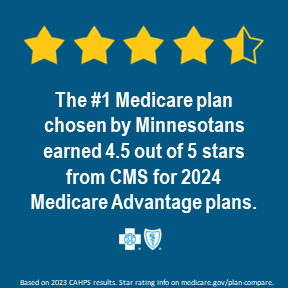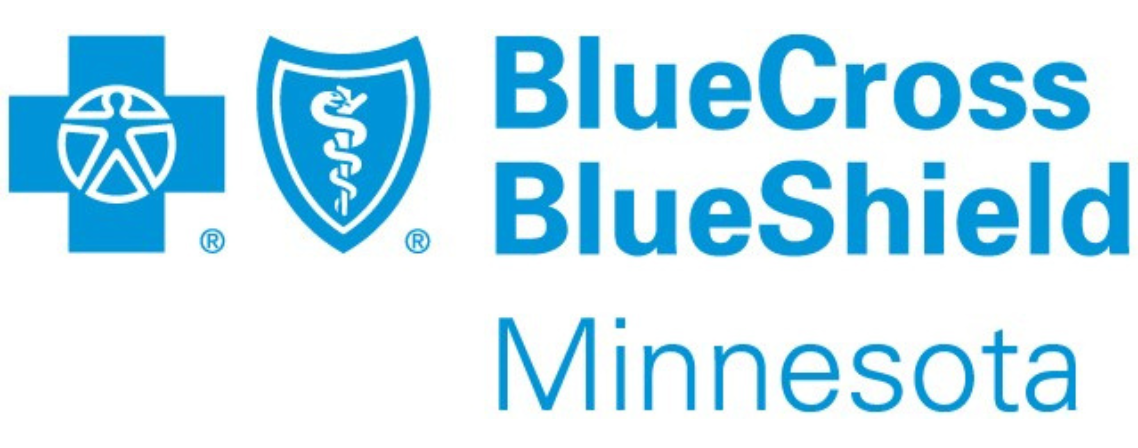It’s All In The Stars: Rating System For Medicare Plans Explained
BLUECROSS BLUESHIELD MN
For more information about the author, click to view their website: BLUE CROSS BLUE SHIELD MINNESOTA
Jan 06, 2024
Minnesota - Twin Cities Metro Area
Email US
Click to Email UsSeniors
enrolling in Medicare often are surprised to discover that most Medicare health
and prescription drug plans are measured by a five‑star rating system. Much
like a reviewer guide to restaurants or hotels, Medicare plans are ranked from
a low of one star to a high of five stars.
The
overall ratings provide an easy and intuitive way to help people evaluate and
compare both the quality of the product being offered and the overall
experience of real consumers.
For
2024 plans, Blue Cross Medicare Advantage and Platinum BlueSM Cost plan members will be enrolled in a 4.5
out of 5-Star Rated plan. Additionally, Blue Cross Medicare Advantage plans are
top-rated by its members for customer service receiving 5 out of 5-Stars[i].
Star Rating categories
These ratings are based on the plan’s performance in five categories:
Keeping people healthy: screening tests and vaccines.
Includes whether members received appropriate preventative screening tests,
vaccines, and other check-ups to help them stay healthy
Managing chronic (long-term) conditions: Includes how often
members with certain conditions got recommended tests and treatments to help
manage their condition
Member experience: Includes actual member’s ratings of the
plan
Member complaints and changes in the health plan’s
performance: Includes how often Medicare found problems with the plan and how
often members had problems with the plan
Health plan customer service: Includes how well the plan handles member appeals
Developed
by Centers for Medicare and Medicaid Services (CMS), the Star Rating system is
based on member surveys as well as information provided by doctors, health care
providers and Medicare's regular monitoring activities. The standards are
evaluated on an annual basis and are built to drive continuous improvement in
the health care system and better health outcomes for Medicare enrollees.
Shopping for a Medicare Plan
Evaluating
a Medicare plan should take other factors into account as well, such as covered
benefits and which doctors, clinics and hospitals are included in the network.
Also, the Medicare Annual Enrollment Period (AEP) from October 15 to December 7
is a great time to review your plan selection each year and make sure it's
still the best fit for your needs. Related reading: From networks to
enrollment periods, get smart on Medicare Advantage plans.
Getting
help sorting through your options is easy (and free!) with a licensed advisor.
Blue Cross Advisors are available in your area for face-to-face meetings,
telephone consultations or virtual visits. Appointment scheduling is available
online at bluecrossmn.com/advisors.
Backed
by a service team of nearly 500 Minnesota-based Member Experience Advocates,
Blue Cross retains 95% of its Medicare enrollees from one plan year to the
next. According to a Blue Cross survey earlier this year, nearly all (98%) of
Medicare-enrolled Minnesota seniors consider customer service to be an
important factor within their plan. More information about Blue Cross’ Medicare
plans can be found at BlueCrossMN.com/medicare.
Editor's
note: Every year, Medicare evaluates
plans based on a 5-star rating system. Blue Cross offers PPO, HMO-POS,
Cost and PDP plans with Medicare contracts. Enrollment in these Blue Cross
plans depends on contract renewal.
2024
Star Ratings are based on services and care members received in 2022 and are
posted at Medicare.gov.
[1] Based on 2023 CAHPS results. Star rating information is on medicare.gov/plan-compare.
- To view the original version of this article visit blog.bluecrossmn.com/longevity/stars-rating-system-medicare-plans-explained/
- Seniors Blue Book was not involved in the creation of this content.
Other Articles You May Like
Retiring Early? Your Health Coverage Strategy Just Became Mission-Critical
Suppose youre an early retiree living on a fixed income. In that case, 2026 brings confirmed changes you need to understandespecially around staying under the 400% Federal Poverty Level (FPL) to maintain ACA premium subsidies.The Two Key Updates:Enhanced ACA tax credits will expire after 2025.Congress has now passed legislation letting the expanded premium tax credits (originating in the American Rescue Plan and extended by the Inflation Reduction Act) lapse beginning in 2026.The subsidy cliff returns in 2026. With enhanced credits eliminated, the traditional cutoff at 400% FPL is reinstated, and crossing that threshold could result in the loss of all subsidy eligibility, leading to significant premium increases. What Early Retirees Should Know On-Exchange (Marketplace) Plans:Subsidy eligibility will once again be limited to households at or below 400% FPL. Exceeding that income level in 2026 could mean losing all premium assistance and facing significantly higher costs.Off-Exchange Plans:These are direct-to-carrier, full-price planswith no subsidies or Marketplace involvement. Silver options might offer better pricing directly through the carrier than on the Marketplace.Consider Smart Income Planning:To retain subsidies, many early retirees are working with both their broker and financial advisor to manage how income is recognized throughout the yearsuch as timing withdrawals or shifting income sourcesto remain under the 400% FPL threshold.This is not financial advicejust a reminder to consult trusted professionals. Aligning your retirement income strategy with your healthcare needs can help maintain premium support until you become eligible for Medicare.Why It Matters:Exceeding 400% FPL in 2026 could result in hundreds of dollars more per month in premiums.With no Medicare yet, coverage costs could remain high for years.Thoughtful income planning now can preserve subsidies during your critical early retirement years.Final Thoughts:As an early retiree, planning is essential. Your health coverage and income are deeply interconnected, primarily through 2026 and beyond.To navigate these changes successfully:-Consult both your financial advisor and your health insurance broker-Monitor your FPL percentage annually.-Strategize income timing and coverage decisions together. If youd like to explore your optionsor are curious how this applies to your householdplease feel free to reach out to us at Baker Consulting Services at 724-594-7648.
Will Federal Medicaid Changes Affect Colorados Long-Term Care Medicaid? Heres the Answer
Will Federal Medicaid Changes Affect Colorados Long-Term Care Medicaid? Heres the Answer President Trumps One Big Beautiful Bill (OBBBA) certainly includes far-reaching revisions to Medicaidcuts to provider taxes, new work requirements, tighter eligibility checks, and billions in savings over a decade. But Colorados long-term care Medicaidcovering nursing homes, home health, and other LTSS (long-term services and supports)has unique state safeguards that ensure it remains insulated from these changes. 1. Federal Cuts Mostly Affect Expansion and Non-Elderly AdultsThe OBBBAs primary targets are Medicaid expansion, non-disabled adults, and children, via work requirements and cost-sharing policies. These reforms are expected to phase in during 20272028. In contrast, long-term care beneficiariestypically seniors and people with disabilitiesfall under separate eligibility categories that the bill doesnt restructure. 2. States Can Shield Long-Term Care FundingColorado funds long-term care services through its Medicaid waiver system. The OBBBA reduces providers taxes and places new caps on expansion enrollment, but it does not limit waivers for nursing homes or home- and community-based services. Even without adjusting, Colorado can preserve funding by prioritizing these essential services over general expansion. 3. Colorados Bipartisan Commitment to Aging ServicesColorado has a long-standing commitment to supporting seniors and people with disabilities. In recent years, the state has steadily increased its share of state funds to match or exceed federal contributions, especially for the elderly population. With broad political consensus, any state-level attempt to curtail waivers would be unlikely. 4. Historical Stability Through Waiver ProtectionsSince implementing the Home- and Community-Based Services (HCBS) Medicaid waiver in 2004, Colorado has used it to support aging in place and reduce institutional costs. These waivers have remained stable across administrations and funding changes. Theres no indication that Trump-era reforms would dismantle this proven framework. 5. National Context Supports StabilitySources like KFF confirm that while OBBBA cuts the Medicaid expansion rate from 90% to 80%, and imposes red tape on enrollment, it does not overhaul LTSS (long-term services and supports). Even health-policy experts acknowledge the targeted nature of the reformfocused on non-elderly groups, not those needing long-term care. Bottom Line for Coloradans Trumps Medicaid changes will significantly affect parts of the system serving non-disabled adults, especially in expansion states. But Colorados long-term care Medicaiddriven by federal waivers, state obligations, and a bipartisan mandatestands apart. Residents access to nursing home care, home-based services, and support for people with disabilities is not at risk.
These 4 Simple Actions May Deliver Big Payoffs for Men's Health
These 4 Simple Actions May Deliver Big Payoffs for Mens HealthIts been 12 months since the last Mens Health Month. Have you seen your doctor?June is a great time to make an appointment for a physical with your primary care provider, and its also an ideal month to educate yourself about some of the issues that impact mens health. For example, did you know that men tend to die five years earlier, on average, than women? Or that men face higher risks for health conditions such as lung cancer, heart disease and HIV? And theyre also at risk for sex-specific cancers, including prostate cancer and testicular cancer (learn about those facts and more via the Office of Disease Prevention and Health Promotion).There are many simple actions men can take to benefit their health, this month and every month. Here are four ways to get started.Tip 1If you dont have a primary care doctor, select one. Establishing a relationship with a doctor is important. That person can help you feel better when youre sick, and they can offer advice on how to feel and stay your healthiest. And yet, according to a survey by the Cleveland Clinic, many men arent taking actions to stay healthy. Nearly two in five Gen Z men dont have a primary care provider (PCP). And when it comes to annual physicals, just 32% of millennials and Gen Z men get them, compared to 61% of Gen X and Baby Boomers. A primary care doctor can test your cholesterol and blood pressure, keep you up-to-date on immunizations and advise you on which screenings you need. A PCP visit is like a one-stop shop for your health!Tip 2If youre worried about your mental health, talk to a professional. Its tough to ask for help, and the statistics show that men, in particular, struggle when it comes to addressing their mental health challenges. According to the Anxiety and Depression Association of America, nearly one in 10 men experience some sort of anxiety or depression, but fewer than half seek treatment. If you find that youre feeling unhappy or irritable, and youre avoiding or not getting pleasure from activities you usually enjoy, talk to your doctor or connect with a therapist and share the way youre feeling. They may be able to help.Tip 3Strengthen your support system. Research shows that social connections are important for your mental and physical health; in fact, people with strong social connections may actually live longer. Prioritize connecting with old friends and open your mind to ways to meet new ones. Itll be good for all involved!Tip 4Practice good health habits. There are everyday actions you can take that are known to be good for your health. Those include regular exercise (aim for 30 minutes of movement, five times a week); eating a healthy diet filled with lean proteins, whole grains and lots of fresh fruits and vegetables; finding outlets to manage your stress, such as yoga or deep breathing; getting enough sleep; quitting tobacco; and moderating how much alcohol you drink (the US guidelines recommend two drinks a day or less for men and one a day or less for women).Making healthy choices isnt hard, but you may need to adjust to some changes in your routine. Before long, those healthy choices may make you feel good enough that you wouldnt want to choose any other way.Contact Blue Cross Blue Shield of Alabama located in Mobile at 251-344-2115.


